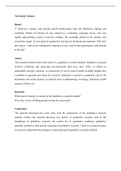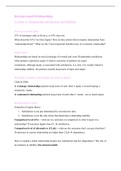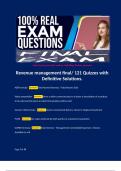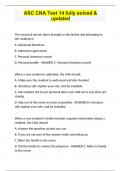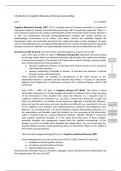CRW2601
NOTES
, 1.1 Retributive theory
Retribution is the restoring of the legal balance caused by the crime
Punishment is the payment of the account
Retribution ≠ vengeance (lex talionis)
Extent of the punishment must be proportionate to the extent of the harm done or of the violation of the law.
Punishment expresses society's condemnation of the crime
Theory explains the need for general requirement of liability known as “culpability” (mens rea) by presupposing
free will.
1.2 Preventative theory
Theory says that the purpose of punishment is the prevention of crime.
Can overlap with deterrent and reformative theories.
Theory is only applied when a real possibility exists that the offender will again commit a crime: previous
convictions point to repeat offenders.
1.2.1 Criticism
Difficult to determine whether offender will again commit crime.
1.3 Individual deterrence
Teach the individual person convicted of a crime a lesson which will deter him from committing crimes in the
future.
1.3.1 Criticism
Undermined by high percentage of recidivists in our jails.
, 1.4 General deterrence
Theory says the purpose of punishment is to deter society as a whole from committing crime.
Success of the theory depends not on the severity of the sentence, but on how strong the probabilities are that an
offender would be caught, convicted and serve out his sentence.
1.4.1 Criticism
1. Is based upon the premise that man prefers the painless to the painful, and that he is a rational
being who will always weigh the advantages and disadvantages of a prospective action before he decides to
act.
2. There is no empirical proof of efficacy of theory.
3. If one applies this theory, it becomes permissible to impose a punishment which is not
proportional to the harm inflicted when the offender committed the crime, but which is in fact higher than a
sentence which is exactly proportional to the harm.
1.5 Reformative / Rehabilitation theory
Says that the purpose of punishment is to reform the offender as a person.
Emphasis is placed on the person & personality of offender.
Theory says an offender commits a crime because of some personality defect, or because of psychological factors
flowing from his background
1.5.1 Criticism
1. Difficult for a court to ascertain how long it would take to reform an offender.
2. Theory does not necessarily imply that the period of imprisonment ought to be proportionate to the harm
inflicted.
3. Effective only where the offender is a relatively young person.
4. Rehabilitation of the offender is more often than not an ideal rather than a reality.
5. Not necessary to wait for a person to commit a crime.
6. Depersonalizes the offender by not regarding him as a free moral agent.
, 1.6 Combination Theory
Theory applied in practice by the courts is the combination theory.
Retribution forms the backbone.
Zinn 1969 describes factors court keeps in mind:
1. Crime
2. Criminal
3. Interests of society
2. South African Criminal Law
2.1 Introduction
SA law is not codified.
Our criminal procedure is codified in the Criminal Procedure Act 51 of 1977.
Before a person can be convicted the principle of legality must be proved, i.e. is whether
the act is a crime.
Principle of legality is not an element of the crime.
3. Elements of Criminal Liability
1. Act or conduct
2. Compliance with the definitional elements of the crime
3. Unlawfulness
4. Culpability
NOTES
, 1.1 Retributive theory
Retribution is the restoring of the legal balance caused by the crime
Punishment is the payment of the account
Retribution ≠ vengeance (lex talionis)
Extent of the punishment must be proportionate to the extent of the harm done or of the violation of the law.
Punishment expresses society's condemnation of the crime
Theory explains the need for general requirement of liability known as “culpability” (mens rea) by presupposing
free will.
1.2 Preventative theory
Theory says that the purpose of punishment is the prevention of crime.
Can overlap with deterrent and reformative theories.
Theory is only applied when a real possibility exists that the offender will again commit a crime: previous
convictions point to repeat offenders.
1.2.1 Criticism
Difficult to determine whether offender will again commit crime.
1.3 Individual deterrence
Teach the individual person convicted of a crime a lesson which will deter him from committing crimes in the
future.
1.3.1 Criticism
Undermined by high percentage of recidivists in our jails.
, 1.4 General deterrence
Theory says the purpose of punishment is to deter society as a whole from committing crime.
Success of the theory depends not on the severity of the sentence, but on how strong the probabilities are that an
offender would be caught, convicted and serve out his sentence.
1.4.1 Criticism
1. Is based upon the premise that man prefers the painless to the painful, and that he is a rational
being who will always weigh the advantages and disadvantages of a prospective action before he decides to
act.
2. There is no empirical proof of efficacy of theory.
3. If one applies this theory, it becomes permissible to impose a punishment which is not
proportional to the harm inflicted when the offender committed the crime, but which is in fact higher than a
sentence which is exactly proportional to the harm.
1.5 Reformative / Rehabilitation theory
Says that the purpose of punishment is to reform the offender as a person.
Emphasis is placed on the person & personality of offender.
Theory says an offender commits a crime because of some personality defect, or because of psychological factors
flowing from his background
1.5.1 Criticism
1. Difficult for a court to ascertain how long it would take to reform an offender.
2. Theory does not necessarily imply that the period of imprisonment ought to be proportionate to the harm
inflicted.
3. Effective only where the offender is a relatively young person.
4. Rehabilitation of the offender is more often than not an ideal rather than a reality.
5. Not necessary to wait for a person to commit a crime.
6. Depersonalizes the offender by not regarding him as a free moral agent.
, 1.6 Combination Theory
Theory applied in practice by the courts is the combination theory.
Retribution forms the backbone.
Zinn 1969 describes factors court keeps in mind:
1. Crime
2. Criminal
3. Interests of society
2. South African Criminal Law
2.1 Introduction
SA law is not codified.
Our criminal procedure is codified in the Criminal Procedure Act 51 of 1977.
Before a person can be convicted the principle of legality must be proved, i.e. is whether
the act is a crime.
Principle of legality is not an element of the crime.
3. Elements of Criminal Liability
1. Act or conduct
2. Compliance with the definitional elements of the crime
3. Unlawfulness
4. Culpability


